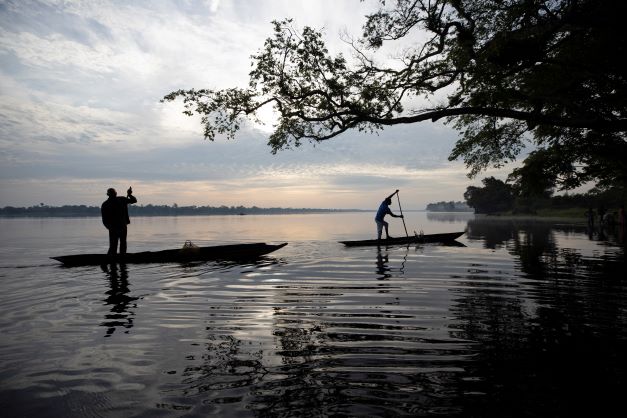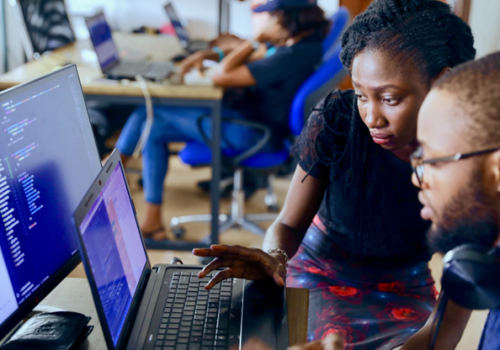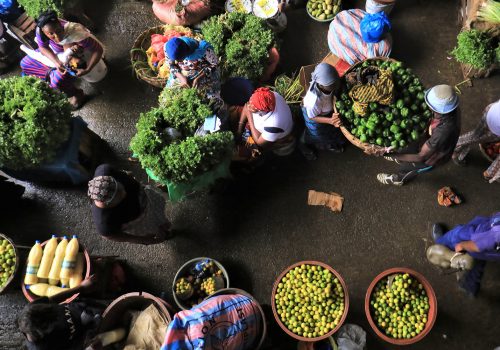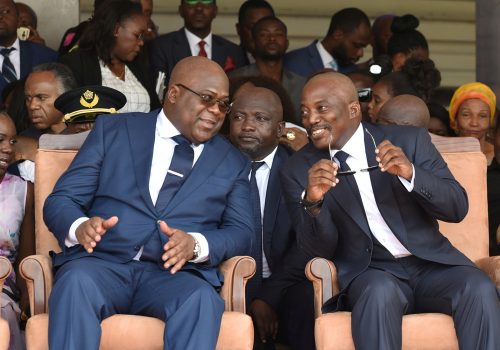In June, the remains of Patrice Lumumba—the Democratic Republic of the Congo’s (DRC) first prime minister—were repatriated from Belgium to his native land, sixty-one years after his assassination. If Lumumba were returning alive to the country today, he would be shocked: His prophecy for a prosperous DRC, which he penned in his final letter to his wife, has not been fulfilled, despite the abundance of natural, economic, human, and cultural resources in the country.
Instead, over decades, an abysmal series of obstacles have repeatedly hindered the country’s development. A poorly managed decolonization process by Belgium, multiple rebellions, and the failure to promote good governance—combined with living in a state of war since 1996, particularly in the east—have resulted in profound setbacks in health, education, the economy, society, and governance.
Those obstacles led to deep and pervasive effects on Congolese society, and they make a good case for massive assistance. There is a model already in place for the United States and other friends of the DRC around the world to follow: the 1948–1951 European Recovery Program, otherwise known as the Marshall Plan. Advanced by then US Secretary of State George C. Marshall, the plan gave countries that were devastated by World War II mostly donations to restore industry, support agriculture, and increase international trade. The United States appropriated $13.3 billion over four years. In the end, the plan helped Western and Southern European countries boost industrial production by 55 percent and average gross national product by 33 percent, laying the foundations for a prosperous Europe. Since then, the expression “Marshall Plan” has been used to refer to massive assistance or economic stimulus programs worldwide, the latest case being the European Recovery Plan.
Comparable assistance focused on improving governance could help the DRC develop while laying a similar foundation for a prosperous African Great Lakes region—and even African continent. Yet, achieving this goal will require focusing the plan more on building strong institutions and less on building infrastructure, the beloved child of many development partners. Then US President Barack Obama emphasized a need for updated partnership programs with Africa in a July 2009 speech in Accra, Ghana, declaring: “The true sign of success is not whether we are a source of perpetual aid that helps people scrape by… It’s whether we are partners in building the capacity for transformational change.”
Decades of development lost
A bit like in the 1960s and 1970s, military conflicts and violence are entrenched in the DRC. The death toll of near-weekly attacks by the allied Democratic Forces (ADF), an insurgent group with ties to the Islamic State of Iraq and al-Sham (ISIS), practically tripled between 2020 and 2022. Furthermore, the militant March 23 Movement, after a deceptive slumber, has occupied the strategic town of Bunagana since June.
After former President Mobutu Sese Seko’s three-decade single-party rule and former President Joseph Kabila’s tumultuous terms from 2001 to 2019, Congolese people hoped that their political class would mobilize in favor of development. This has not yet fully happened; and far from rallying the much-needed unity required to end the conflict in the east, political parties seem preoccupied with the 2023 presidential election.
Despite recent social and economic progress—notably a solid annual gross domestic product (GDP) growth rate that has averaged above 5 percent over the last ten years—many long-term per capita indicators have worsened since the 1970s, according to the World Bank: Electricity consumption per capita (159 kilowatt hours in 1972 and 109 kilowatt hours in 2015) and the number of hospital beds per thousand people (3.2 in 1975 against 0.8 in 2006) have dropped. Gross domestic product (GDP) per capita remains less than half of values in the 1970s ($1,372 in 1974 versus $518 in 2021, in constant 2015 US dollars).
There are several other indicators that raise concerns about the country’s economic and social progress: As of the beginning of this year, twenty-one diseases under surveillance in the DRC had the potential to become epidemics—and in the year before, six had done so, including measles, cholera, and COVID-19. According to the United Nations (UN) Office for the Coordination of Humanitarian Affairs, 4.2 million people, including 2.4 million children under five years old, suffer from acute severe malnutrition. Roughly six million people are internally displaced, and 74,000 cases of sexual and gender-based violence were reported over the period, with the majority occurring in the eastern conflict-torn part of the country.
These economic and social indicators are a sign of an unhealthy ecosystem that cannot support development. Contributing factors include political instability, wars, a lack of economic diversification, an overreliance on natural resources, and the consequences of a conflict economy—in which investment is dampened by the uncertainty caused by wartime disruptions to local and national activities, and Congolese don’t benefit from the revenues created by their natural resources. These factors make it difficult to uproot corruption, mismanagement, and state capture, even more than half a century after the DRC’s independence, despite recent efforts, such as reforms within the central bank and the publication of mining contracts.
Thus, the country’s lack of development, caused by its political, social, and economic conditions, is likely to be long-lasting.
The “big push” to prosperity
In his farewell letter, Lumumba was optimistic about the destiny of his country because he believed that the DRC could overcome its afflictions, just as other countries that have experienced war and political instability have done.
Germany experienced such a period of economic and social adversity after World War II: In 1947, industrial output was only one-third and food production was one-half of the country’s 1938 levels. Nearly one-fifth of the country’s housing had been destroyed over the course of the war. Inflation had resulted in a wave of poverty, while the country’s price controls fueled the expansion of the black market.
But today, Germany has become a formidable economic force. The reasons for the German economic miracle, or “Wirtschaftswunder,” are subject to debate among economists, but some credit the Marshall Plan.
The initial Marshall Plan and its variants worldwide are in line with economist Paul Rosenstein-Rodan’s “big push” theory that massive reforms and investments are more helpful than gradual actions in overcoming obstacles that preclude development in underdeveloped economies. In other words, a “big push” is required to undo the inertia of a stagnant economy. Such a “big push” would help the DRC get out of its rut, given the country’s numerous and multifaceted economic, social, and security challenges. But the push must address the real issues that Congolese face.
Institutions over infrastructure
Investment plans for African countries often focus on spending in areas like infrastructure and equipment—and ultimately, some costly and not terribly useful “white elephants.” A Marshall Plan for the DRC should avoid falling into those two pitfalls by taking a completely different approach: focusing on institutions rather than infrastructure.
After all, infrastructure projects in the DRC easily mobilize resources from a variety of public and private stakeholders. The Emirati company DP World, for example, is investing hundreds of millions of dollars over decades in the construction and management of the DRC’s first deep-sea port in Banana due to the economic potential there. Beyond that case, the country’s infrastructure potential and needs are so immense that all that the government would have to do is to design bankable projects and abide to the conditions set by international private or public partners.
Conversely, commitment to lasting and in-depth institutional reform is far below what the DRC and other poor nations need because a reformed institution is less immediately visible than a bridge or a school. In addition, reforming or even creating an institution is more time-consuming, more complex, and dependent on combining success factors such as overcoming vested interests and tailoring institutions to sociological realities. It involves mapping and optimizing processes, investing in training, and paying civil servants better—but also limiting abuses vis-à-vis users of public services, who are often not considered as customers but rather as sheep that can be sheared mercilessly.
Overcoming the DRC’s development obstacles will require a substantial investment in the country’s institutions. Strong institutions are the key to turning the DRC’s immense potential into tangible results, enabling the country to fish for itself instead of being offered fish by other countries.
A DRC with strong institutions would see civil servants better paid, unbiased decisions from the courts, vulnerable groups protected by the police, natural resources and projects managed without corruption, better-equipped schools, and a social safety net that protects the most vulnerable.
Preparing for the push
Initial work in designing the Marshall Plan should start with an in-depth inclusive discussion among Congolese and between Congo and its partners about the governance mechanisms of such an initiative.
This initial discussion is essential because of the colossal sums at stake and also the controversies that have plagued Congolese infrastructure projects: In order to avoid problems associated with the DRC’s poor public finance management and to increase the likelihood that the plan succeeds, this discussion should be structured around strengthening its absorptive capacity—the amount of foreign aid that the DRC can use productively. The DRC has faced difficulties in quickly implementing quality investment projects and ensuring that every dollar invested reaches its intended beneficiary. Shaping a new normal will require improvements in three areas.
- Preparations for the Marshall Plan should include the recruitment and training of motivated and skilled people who can effectively design and manage reform projects in the long term.
- The DRC must establish a stronger and more efficient control mechanism to ensure good fiduciary management of the plan’s projects in order to avoid misappropriation, collusion, and corruption. Such practices have long bedeviled public contract tenders and public funds management.
- It will be necessary to meticulously prepare the various projects and investment plans in order to avoid mistakes of the past, including some famous white elephants, and to guarantee adequate social impact. To do this, leaders taking part in the plan should adopt an experimental approach in which they run small-scale test projects to better understand and correct their shortcomings before deploying them throughout the country.
Institution building is a serious matter. It requires time and stability. Besides, institutional quality is sensitive to policy changes that follow shifts in political leadership. Hence the need, as a foundation to the Marshall Plan, to build a clear, accountable, and trans-partisan consensus around institutional reform. If a platform for reform has buy-in from political parties and stakeholders across Congolese society, it would be immune to the negative side effects of changes in government. With new elections slated for 2023, now is an opportune political moment to start that dialogue. Presidential candidates, in particular, should explain how their pledges will contribute to the much-needed institutional transformation. The country’s burgeoning civil society could seize the opportunity to mobilize Congolese across party lines and identify priority sectors for institution building in preparation for the plan.
Such a process would empower the Congolese people, who have often been marginalized in designing development policies even though they’re meant to be the beneficiaries. It would foster crucial local commitment to institutional transformation. Plus, the preparation effort could help establish an equal relationship between the DRC and its financial partners in their mission to propel the country into the twenty-first century.
Doing the Marshall Plan math
How much should an institutional Marshall Plan for the DRC cost? Let’s start with a linear method to evaluate the original.
From 1948 to 1952, sixteen countries received a total of $13.3 billion, representing roughly $159 billion in 2022. Distributing that among the total 1948 population (approximately 270 million) of the countries that received this aid yields a per capita endowment of $588 in today’s dollars to match the original Marshall Plan.
That would add up to approximately $55 billion for the DRC and its estimated 95.2 million people. The amount is practically the size of the DRC’s GDP and more than ten times what it receives in annual Official Development Assistance. It may seem enormous—but that is not the case considering the scale of the DRC’s weak social indicators and immense needs. The sum is about one-third more than the $40 billion the US Congress committed this year to aid Ukraine in its fight against Russia, and represents roughly three to four years of expenditures for Washington, DC, or Chicago.
The spillovers from the Marshall Plan would also be transformative; those resources would help provide the “big push” that the country needs to fight against the rise of the ADF in eastern DRC, meet its development challenge, rebuild, and, above all, consolidate its governance and move from a cyclical, natural-resource-led growth to a more balanced and sustainable momentum supported by strong institutions.
A Marshall Plan-style investment could quickly transform the DRC, which is projected to become the world’s eighth most populous country by 2050, into one of the globe’s most dynamic markets. The DRC, with its connections to world cobalt battery supply chains, could also become a home for green industries, with jobs available for youth in all sectors of a radically transformed economy.
Ultimately, an institution-centered Marshall Plan would dramatically transform the DRC over the next decades, helping new generations of Congolese achieve Lumumba’s vision of a bright future for the country, the region, and for Africa.
Jean-Paul Mvogo is a nonresident senior fellow at the Atlantic Council Africa Center.
Further reading
Thu, Jun 16, 2022
Better data is the key to unlocking major investment in Africa
AfricaSource By Tom Koch
As COVID-19 and the war in Ukraine continue to hurt the African continent, many countries will require significant investment to revitalize their economies. But a persistent attribute of many African markets will continue to be a barrier to private investment: a relative lack of data. This drives up diligence costs, creates difficulties in valuing assets, […]
Tue, May 25, 2021
Africa is America’s greatest geopolitical opportunity. Does the US know it?
AfricaSource By Rama Yade
Biden can further build ties with Africa: He should do so not only because these countries have long been underrepresented within leading multilateral organizations, but also because they offer innovative solutions to global challenges including terrorism, climate change, migration, debt, and COVID-19.
Tue, Jan 14, 2020
Congo, one year later
AfricaSource By
Overall, while there has clearly not been any regime transition in Congo, there are faint stirrings of change. It is long shot, but it seems that the Western strategy of embracing Tshisekedi in exchange for Kabila’s removal from office may yet – possibly, hopefully – bear some fruit.



